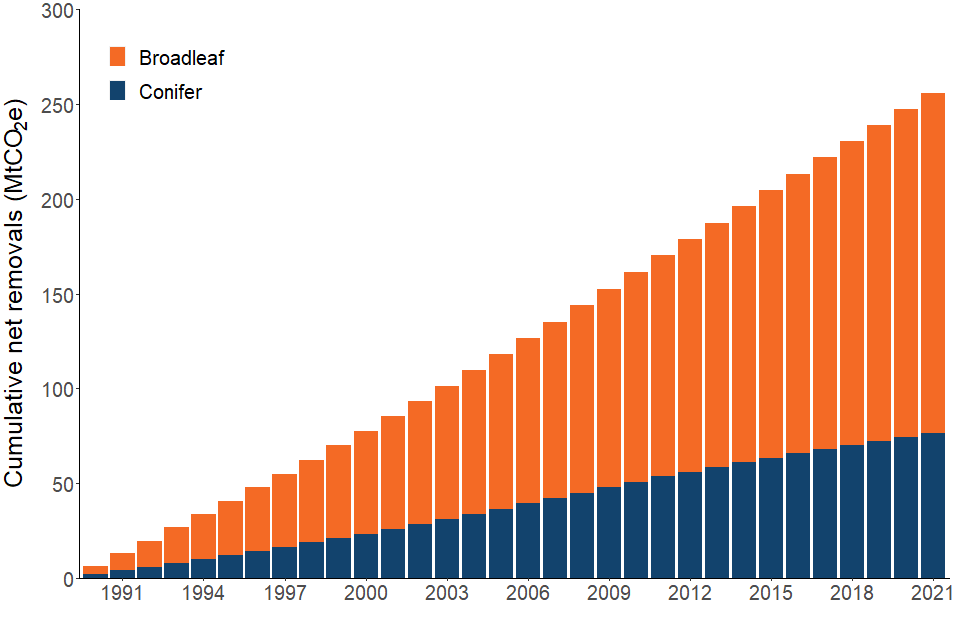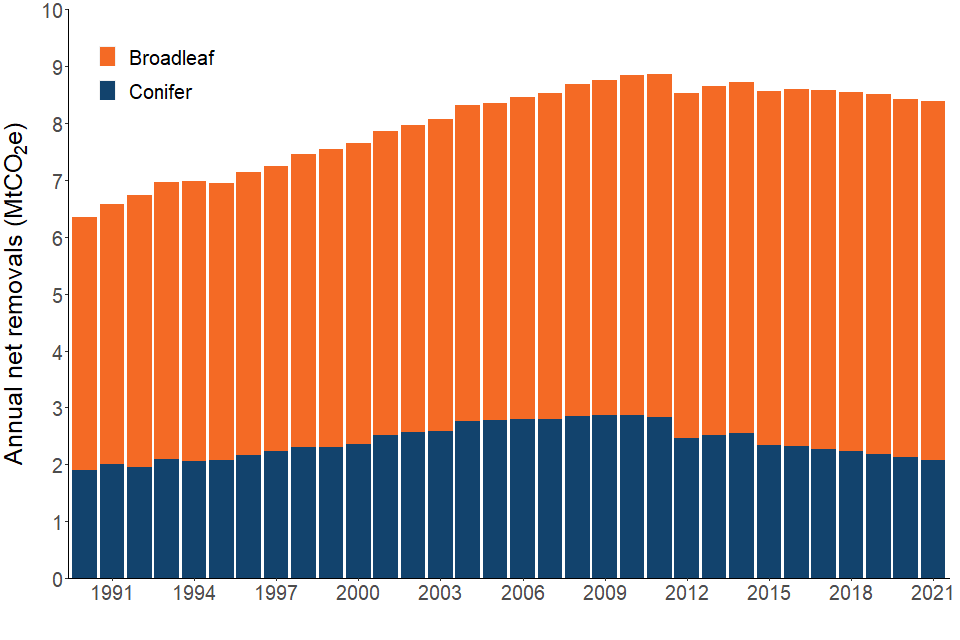9. Biodiversity and ecosystem services: greenhouse gas removal by forests
Updated 3 May 2024
Applies to England
Data last updated: November 2023
Latest data available:
- Cumulative/annual net removals of greenhouse gases by forests in England - 2021
- Total carbon stocks in living conifer and broadleaved woodland trees in England - 2020
Introduction
Forests are a large store of carbon and also act as an active carbon ‘sink’, removing carbon dioxide (CO2), a greenhouse gas (GHG), from the atmosphere and storing it as carbon in living biomass, leaf litter and forest soil. This sequestration of CO2 is an essential ecosystem service.
This indicator shows the cumulative net removal of greenhouse gases from the atmosphere by forests in England since 1990. It is split between type of woodland (conifer and broadleaf). Showing greenhouse gas removals by type of woodland is interesting from a biodiversity perspective as it allows a clearer presentation of the contribution made to greenhouse gas removals by broadleaf woodland, most of which constitutes priority habitat.
Type of indicator
Benefit indicator
Assessment of change in cumulative net removal of greenhouse gases by forests
- Long term (1990 to 2021): Improving
- Short term (2016 to 2021): Improving
- Latest year (2020 to 2021): Increased
Note on indicator assessment
Long- and short-term assessments are based on a 3% rule of thumb. Where possible, the base years for these assessments use a three-year average. See Assessing indicators.
Removal of greenhouse gases by forests in England
Trend description for Figures 9.1 and 9.2
It is estimated that from 1990 to 2021, forests in England have (cumulatively) removed the equivalent of 256 million tonnes of carbon dioxide (MtCO2e) from the atmosphere (Figure 9.1). In 2021, English forests are estimated to have removed 8.4 MtCO2e (Figure 9.2).
The proportion of greenhouse gases removed from the atmosphere by broadleaf woodland in England has fluctuated through the time series, but was greater in 2021 than when the time series began, accounting for 75% (6.3 MtCO2e) of the estimated annual removals in 2021 compared to 70% (4.5 MtCO2e) of removals in 1990 (Figure 9.2).
Figure 9.1: Cumulative net removals of greenhouse gases by forests in England, 1990 to 2021

Source: Department of Business, Energy & Industrial Strategy (BEIS) – Land Use, Land Use Change and Forestry (LULUCF) greenhouse gas inventory.
Download the data for Figure 9.1 in ods format
Notes about Figure 9.1:
- Estimated cumulative net removals of greenhouse gases (carbon dioxide (CO2), methane (CH4) and nitrous oxide (N2O) from the atmosphere by forests in the UK, expressed as million tonnes of CO2 equivalent (Mt CO2e).
- Revised in 2015 to reflect improved modelling of greenhouse gas emissions and removals.
- Revised in 2019, 2020, 2021 and 2023 due to further improvements in the CARBINE model and forest planting and harvesting statistics in all four years and implementation of peatlands research in 2021 (see Background section for more details).
- These results are therefore not directly comparable with those in previous publications.
Relevance
The benefits that humans receive from the environment have become more widely recognised. The Millennium Ecosystem Assessment and the more recent UK National Ecosystem Assessment both highlighted that ecosystems and the services they deliver underpin our very existence. We depend on them to produce our food and timber, regulate water supplies and climate, and breakdown waste products. We also value them in less obvious ways: contact with nature gives pleasure, provides recreation and is known to have a positive impact on long-term health and happiness. Measuring the status of ecosystem services is therefore a critical aim of the indicator set. Greenhouse gas removal is a regulating ecosystem service that contributes to reducing the scale and future impacts of climate change (that is climate change mitigation).
The indicator is relevant to outcomes 1 and 1c in Biodiversity 2020, the strategy for England’s wildlife and ecosystem services (PDF 2.66 MB). The indicator is also relevant to international goals and targets (see Annex A and B of the aforementioned publication).
Background
The data presented here are from the UK’s Land Use, Land Use Change and Forestry (LULUCF) greenhouse gas inventory, which provides estimates of the annual emissions and removals of greenhouse gases (carbon dioxide (CO2), methane (CH4) and nitrous oxide (N2O)) from the atmosphere by forests in the UK between 1990 and 2021 (Figures 9.1 and 9.2). LULUCF emissions and removals are given in terms of carbon dioxide equivalent (CO2e). The CO2e of a mixture of greenhouse gases is the quantity of CO2 that would have the same global warming potential.
English forests are a large store of carbon and also act as an active carbon ‘sink’, removing CO2, a greenhouse gas, from the atmosphere and storing it as carbon in living biomass, leaf litter and forest soil. This sequestration of CO2 is an essential ecosystem service.
National Inventories of human-induced sources and sinks of greenhouse gases are submitted by Parties, including the UK, to the United Nations Framework Convention on Climate Change (UNFCCC) every year. This system was set up to meet the reporting obligations of the Convention and is used to report on progress in meeting Kyoto Protocol commitments. The Kyoto Protocol, which entered into force in 2005, obliges industrialised countries that have ratified the accord to reduce their emissions of 6 greenhouse gases, the major contributors being CO2, CH4 and N2O. The LULUCF greenhouse gas inventory covers emissions and removals of these 3 greenhouse gases resulting from direct human-induced land use, land-use change and forestry activities. The LULUCF estimates are compiled for the Department for Business, Energy and Industrial Strategy (BEIS) by the UK Centre for Ecology & Hydrology (UKCEH) and Forest Research (FR).
The forestry figures in the 1990 to 2021 LULUCF inventory have been revised and therefore the figures presented here are not directly comparable to those in previous publications. Changes are due to improvements made to the FR CARBINE model and a full explanation of the (most recent) changes can be found on page 400 of the National Inventory Report. Briefly, the reported overall net GHG sink in forest land (category 4A, see report) has reduced by between -0.2 and -0.5 MtCO2e (-1 to -3%) across the time-series compared to the previous inventory.
The changes are/relate to:
- Updated activity data.
- Updated EF for POC emissions from organic soils.
- Updated forest area on organic soils.
- Minor changes to average biomass densities used for wildfire emission calculations.
- Updated N2O and CH4 EFs from organic soils.
The effect of these model changes is a decrease in both the broadleaf and conifer forest GHG sinks for all years between 1990 and 2021. More specifically, decreases to the conifer sink were of a greater magnitude than those to the broadleaf sink and decreases to both GHG sinks are more pronounced in the later years of the time-series.
Figure 9.2 shows the annual breakdown of the cumulative removals shown in Figure 9.1. Although the indicator is assessed as improving in both the long term and short term since cumulative greenhouse gas removals have continued to increase, it should be noted that annual rates of removal have remained relatively static over the last 17 years. It is also worth noting that the proportion of removals attributed to broadleaf woodland has fluctuated through the time series, but was greater in 2021 than when the time series began in 1990.
Showing greenhouse gas removals by type of woodland is interesting from a biodiversity perspective as it allows a clearer presentation of the contribution made to greenhouse gas removals by broadleaf woodland, most of which constitutes priority habitat.
Figure 9.2: Annual net removals of greenhouse gases by forests in England, 1990 to 2021

Source: Department of Business, Energy & Industrial Strategy (BEIS) – Land Use, Land Use Change and Forestry (LULUCF) greenhouse gas inventory.
Download the data for Figure 9.2 in ods format
Notes about Figure 9.2:
- Estimated annual net removals of greenhouse gases (carbon dioxide (CO2), methane (CH4) and nitrous oxide (N2O)) from the atmosphere by forests in England, expressed as million tonnes of CO2 equivalent (Mt CO2e).
- Revised in 2015 to reflect improved modelling of greenhouse gas emissions and removals.
- Revised in 2019, 2020, 2021 and 2023 due to further improvements in the CARBINE model and forest planting and harvesting statistics in all four years and implementation of peatlands research in 2021 (see Background section for more details).
- These results are therefore not directly comparable with those in previous publications.
National Forest Inventory
The estimated carbon stock of trees in England can be used as a complementary measure of carbon storage. Information on current carbon stocks of forests in England was first calculated in 2014 using National Forest Inventory (NFI) data, based on a sample of woodlands equal to or greater than 0.5 hectares in size.
Fieldwork for National Forest Inventory data on carbon stock of all species of tree within forests in the UK is conducted every five years. The latest data is to 31 March 2020. At this point, there was estimated to be 125 Mt of carbon (459 Mt CO2e) across all species of tree within forests in England (see Figure 9.3). Broadleaf trees, with an estimated carbon stock of 95.5 Mt (350 Mt CO2e) are responsible for a greater proportion of the total England carbon stock than conifer trees, which are estimated to have a total stock of 30 Mt (109 Mt CO2e). This difference reflects the fact that in England, the total ‘growing stock volume’ (and area) of broadleaved woodland covered by the NFI is greater than that of conifer woodland.
Figure 9.3: Total carbon stocks in living conifer and broadleaved woodland trees in England, 1990 to 2020

Source: National Forest Inventory (Forestry Commission)
Download the data for Figure 9.3 in ods format
Notes about Figure 9.3:
- Estimated total carbon in all living trees within woodlands of England.
- The time series is non-linear (indicated by the dashed vertical lines on the x axis).
Fieldwork for the current NFI began in 2009 and is being conducted on a five-year cycle. The assessment of woodland carbon stocks from this inventory has formed a new baseline for carbon accounting within British forests and woodlands. Estimates of carbon stocks are determined by the total growing stock volume of woodland; a function of:
- Woodland area; and
- Woodland characteristics (e.g. number of trees, tree height and tree diameter) within this area.
The latest NFI fieldwork cycle began in 2015 and ran until 2020. The NFI assessment of woodland carbon stocks was used in the development of the reporting on LULUCF emissions and removals. However, as there are differences in both the scope and the data sources used for LULUCF (sequestration) and NFI (stock) figures, they are not directly comparable. More information can be found in the Forest Research Report (PDF, 1.29Mb).
Web links for further information
- Forestry Commission: Carbon in live woodland trees in Britain: National Forest Inventory Report (PDF, 1.29 Mb)
- Millennium Ecosystem Assessment: Millennium Ecosystem Assessment
- National Atmospheric Emissions Inventory: https://naei.beis.gov.uk/reports/reports?report_id=998h
- UK National Ecosystem Assessment: UK National Ecosystem Assessment
